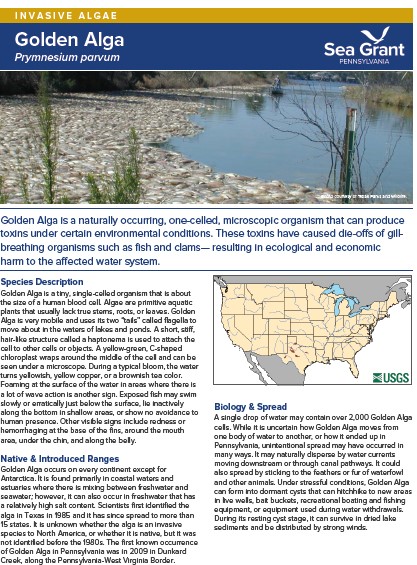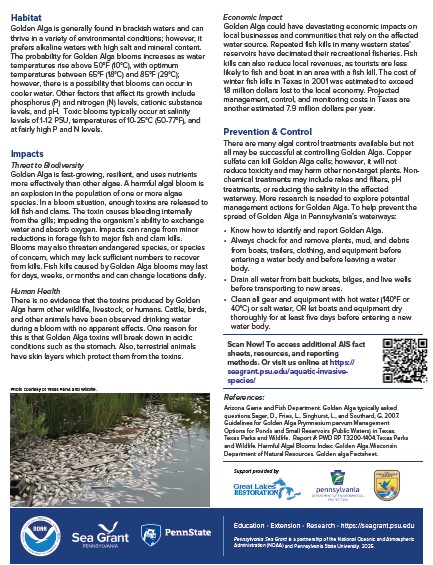Golden Alga (Prymnesium parvum)
Species at a Glance
Golden Alga is a naturally occurring, single-celled, microscopic organism. It is fast-growing, resilient, and under certain conditions, Golden Alga populations can produce toxins that kill fish, clams, and other gill-breathing species, resulting in ecological and economic harm to affected water bodies.


Species Description
Golden Alga is a tiny, single-celled organism that is about the size of a human blood cell. Algae are primitive aquatic plants that usually lack true stems, roots, or leaves. Golden Alga is fast-growing, resilient, very mobile, and it uses nutrients more effectively than other algae. Two “tails” called flagella enable the Golden Alga to move about in the waters of lakes and ponds, and a short, stiff, hair-like structure called a haptonema is used to attach one Golden Alga to another, or to objects.
Native and Introduced Ranges
Golden Alga occurs on every continent except for Antarctica. In North America, it is uncertain whether the Golden Alga is native or introduced, but it was first identified in Texas in 1985. It has since been identified in 15 states. The first known occurrence of Golden Alga in Pennsylvania was in 2009 in Dunkard Creek, along the Pennsylvania-West Virginia Border.
Biology & Spread
A single drop of water may contain over 2,000 Golden Alga cells. The means of travel from one water body to another is uncertain, but it is believed to naturally disperse by water currents moving downstream or through canal pathways. It may also spread by sticking to the feathers or fur of waterfowl and other animals. Under stressful conditions, Golden Alga can form into dormant cysts that can hitchhike to new areas in live wells, bait buckets, recreational boating, and fishing equipment, or equipment used during water withdrawals. During its resting cyst stage, it can survive in dried lake sediments and be distributed by strong winds.
Habitat
Golden Alga is generally found in brackish, coastal waters and estuaries where there is mixing between freshwater and seawater; however, it can also occur in freshwater that has a relatively high salt and mineral content.
The probability for Golden Alga blooms increases as water temperatures rise above 50°F (10°C), with optimum temperatures between 65°F (18°C) and 85°F (29°C); however, there is a possibility that blooms can occur in cooler water. Other factors that affect its growth include phosphorus (P) and nitrogen (N) levels, cationic substance levels, and pH. Toxic blooms typically occur at salinity levels of 1-12 PSU, temperatures of 10-25°C (50-77°F), and at fairly high P and N levels.
Impacts
Threat to Biodiversity
A harmful algal bloom is an explosion in the population of one or more algae species. In a bloom situation, enough toxins are released to kill fish and clams. The toxin causes bleeding internally from the gills; impeding the organism’s ability to exchange water and absorb oxygen. Impacts can range from minor reductions in forage fish to major fish and clam kills. Blooms may also threaten endangered species, or species of concern, which may lack sufficient numbers to recover from kills. Fish kills caused by Golden Alga blooms may last for days, weeks, or months.
Human Health
There is no evidence that the toxins produced by Golden Alga harm terrestrial species such as wildlife, livestock, or even humans. While cattle, birds, and other animals have been observed drinking water during a bloom, stomach acids break down the toxins produced by the Golden Alga. Additionally, terrestrial animals have skin layers which protect them from toxins.
Economic Impact
Golden Alga could have devastating economic impacts on local businesses and communities that rely on the affected water body. Repeated fish kills in many western states’ reservoirs have decimated recreational fisheries. Fish kills can also reduce local revenues, as tourists are less likely to fish and boat in an area with a fish kill. The cost of winter fish kills in Texas in 2001 was estimated to exceed 18 million dollars lost to the local economy. Projected management, control, and monitoring costs in Texas are another estimated 7.9 million dollars per year.
Prevention & Control
There are many algal control treatments available, but not all may be successful at controlling Golden Alga. Copper sulfate can kill Golden Alga cells; however, it will not reduce toxicity and may harm other non-target plants. Non-chemical treatments may include rakes and filters, pH treatments, or reducing the salinity in the affected waterway. More research is needed to explore potential control or management actions for Golden Alga. To help prevent the spread of Golden Alga in Pennsylvania’s waterways:
- Know how to identify and report Golden Alga.
- Always check for and remove plants, mud, and debris from boats, trailers, clothing, and equipment before entering a water body and before leaving a water body.
- Drain all water from bait buckets, bilges, and live wells before transporting to new areas.
- Clean all gear and equipment with hot water (140°F or 40°C) or salt water, OR let boats and equipment dry thoroughly for at least five days before entering a new water body.
References:
Arizona Game and Fish Department. Golden Alga typically asked questions.
Sager, D., Fries, L., Singhurst, L., and Southard, G. 2007. Guidelines for Golden Alga Prymnesium parvum Management Options for Ponds and Small Reservoirs (Public Waters) in Texas. Texas Parks and Wildlife. Report #: PWD RP T3200-1404.
Texas Parks and Wildlife. Harmful Algal Blooms Index: Golden Alga.
Wisconsin Department of Natural Resources. Golden alga Factsheet.



